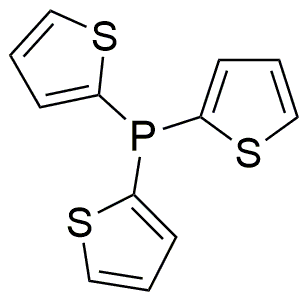Tri(2-thienyl)phosphine is widely utilized in research focused on:
- Catalysis: This compound serves as an effective ligand in various catalytic processes, enhancing reaction efficiency in organic synthesis, particularly in cross-coupling reactions.
- Material Science: It is used in the development of conductive polymers and organic electronics, contributing to advancements in flexible displays and solar cells.
- Pharmaceuticals: Tri(2-thienyl)phosphine plays a role in drug discovery, acting as a building block for synthesizing novel therapeutic agents with potential anti-cancer properties.
- Sensor Technology: This chemical is employed in the fabrication of sensors, particularly for detecting environmental pollutants, due to its sensitivity and selectivity.
- Research in Organophosphorus Chemistry: It provides insights into the behavior of phosphorus-containing compounds, helping researchers understand their reactivity and potential applications in various fields.
General Information
Properties
Safety and Regulations
Applications
Tri(2-thienyl)phosphine is widely utilized in research focused on:
- Catalysis: This compound serves as an effective ligand in various catalytic processes, enhancing reaction efficiency in organic synthesis, particularly in cross-coupling reactions.
- Material Science: It is used in the development of conductive polymers and organic electronics, contributing to advancements in flexible displays and solar cells.
- Pharmaceuticals: Tri(2-thienyl)phosphine plays a role in drug discovery, acting as a building block for synthesizing novel therapeutic agents with potential anti-cancer properties.
- Sensor Technology: This chemical is employed in the fabrication of sensors, particularly for detecting environmental pollutants, due to its sensitivity and selectivity.
- Research in Organophosphorus Chemistry: It provides insights into the behavior of phosphorus-containing compounds, helping researchers understand their reactivity and potential applications in various fields.
Documents
Safety Data Sheets (SDS)
The SDS provides comprehensive safety information on handling, storage, and disposal of the product.
Product Specification (PS)
The PS provides a comprehensive breakdown of the product’s properties, including chemical composition, physical state, purity, and storage requirements. It also details acceptable quality ranges and the product's intended applications.
Certificates of Analysis (COA)
Search for Certificates of Analysis (COA) by entering the products Lot Number. Lot and Batch Numbers can be found on a product’s label following the words ‘Lot’ or ‘Batch’.
*Catalog Number
*Lot Number
Certificates Of Origin (COO)
This COO confirms the country where the product was manufactured, and also details the materials and components used in it and whether it is derived from natural, synthetic, or other specific sources. This certificate may be required for customs, trade, and regulatory compliance.
*Catalog Number
*Lot Number
Safety Data Sheets (SDS)
The SDS provides comprehensive safety information on handling, storage, and disposal of the product.
DownloadProduct Specification (PS)
The PS provides a comprehensive breakdown of the product’s properties, including chemical composition, physical state, purity, and storage requirements. It also details acceptable quality ranges and the product's intended applications.
DownloadCertificates of Analysis (COA)
Search for Certificates of Analysis (COA) by entering the products Lot Number. Lot and Batch Numbers can be found on a product’s label following the words ‘Lot’ or ‘Batch’.
*Catalog Number
*Lot Number
Certificates Of Origin (COO)
This COO confirms the country where the product was manufactured, and also details the materials and components used in it and whether it is derived from natural, synthetic, or other specific sources. This certificate may be required for customs, trade, and regulatory compliance.


